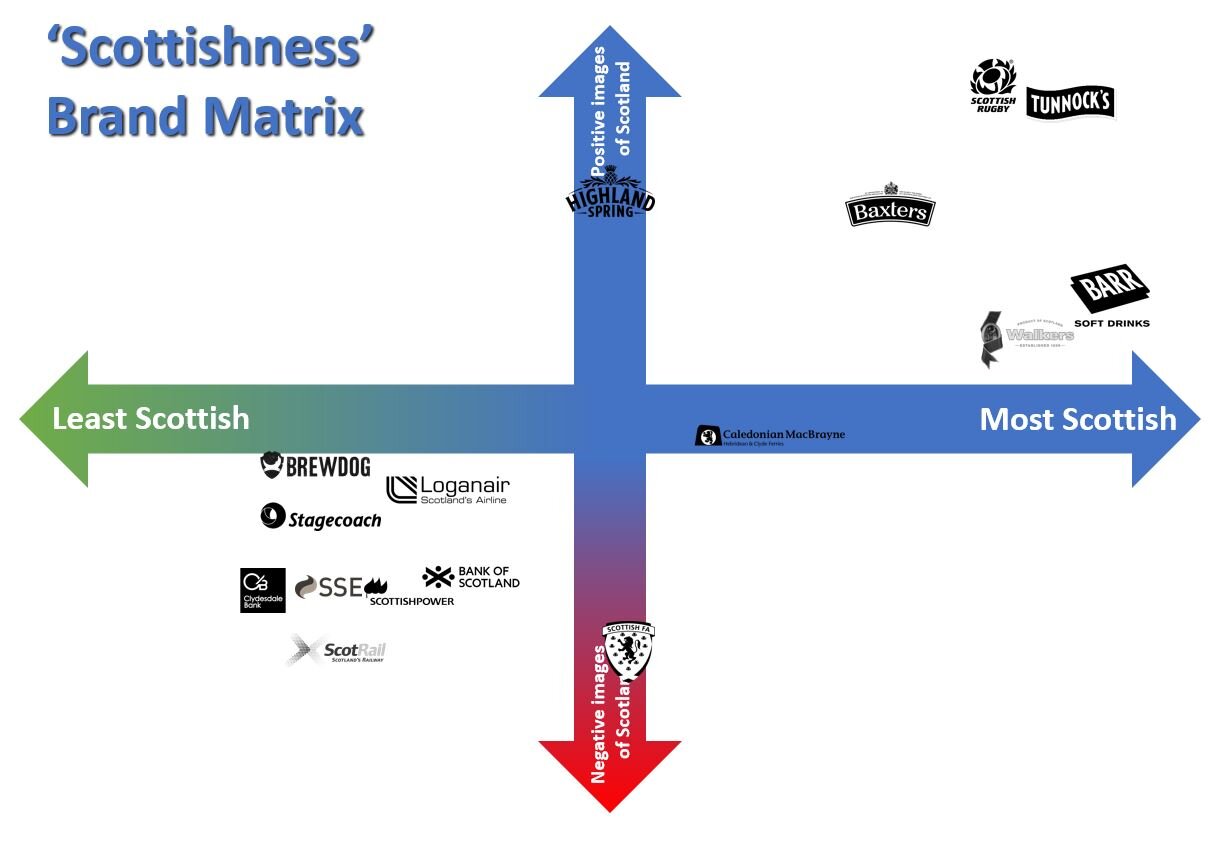16th September 2019:
The role of national identity in enhancing a brand
The 56 Degree Insight team are excited to share the results from our survey of 16 iconic Scottish brands - the 2019 56DI Scottish Brands Index survey. This will be an annual survey which adds a Scottish flavour to brand evaluation – a unique addition to the Scottish marketplace. Each week we will take a look at one of the key metrics of brand success. This week we look at the element which distinguishes our approach from other brand evaluation measures – the contribution of each brand to the image of Scotland…
Introduction
National identity has always been important to Scots – though perhaps more at the moment than at any other time in living memory. The 2014 Independence Referendum resulted in a national debate around identity and despite the outcome – a decision to remain a part of the United Kingdom – this has led to a resurgence in the importance of ‘Scottishness’ generally – and the subsequent political events only seem likely to maintain or enhance this sense of Scottish identification among the population.
But even as far back as the last census – in 2011 – the identification of most Scots with being ‘Scottish’ rather than ‘British’ was evident. 62% of the total population stated their identity was ‘Scottish only’. That proportion varied from 71% for 10 to 14 year olds to 57% for 30 to 34 year olds. The second most common response was ‘Scottish and British identities only’, at 18%. This was highest in the 65 to 74 age group, at 25%. ‘British identity only’ was chosen by 8% of the population. The highest proportion stating this identity was the 50 to 64 age group (10%).
And this sense of identification with Scotland extended to ethnic groups as well. Some 34% of all minority ethnic groups felt they had some Scottish identity either on its own or in combination with another identity. The figure ranged from 60% for people from a mixed background and 50% for those from a Pakistani ethnic group, to 21% for those from an African ethnic group. This compared to 83% for all people in Scotland.
So what relevance is this to Scottish brands? We would argue that the degree of Scottishness is also important for many Scots when it comes to our brands. Only a fortnight ago, we published the results of a survey of Scots adults which explored how Scots felt about food and drink branding some 3 years’ on from the decision by Tesco, on the back of claimed complaints by English customers, to change the branding of their strawberries and replace the Scottish saltire on the packaging with the union flag. Three years’ on, we were keen to see how Scots felt about food branding:
When food shopping in Scotland, if you were to see two identical food items available at the same price, one with a UK flag and labelled ‘100% British product’ and the other with a Scottish flag and labelled ‘100% Scottish product’, which would you be more likely to buy?
The results provided a clear direction to food manufacturers and retailers when selling Scottish produce within Scotland – the importance of using a Scottish branding was clear:56% would choose the product branded ‘Scottish’ whereas only 4% would choose the ‘British’ labelling. The remaining 39% were ambivalent, saying it would ‘make no difference’. Older consumers were more likely to choose ‘Scottish’ over ‘British’ – 66% of those aged 45-64 compared with 43% of the under 35s.It’s not that the younger group were more likely to buy ‘British’, they were simply more ambivalent (54% saying it would make no difference).
Irrespective of personal opinions, what is clear is that when marketing goods and services to Scots, managers of Scottish brands should at least be aware of the possible advantages of highlighting Scottishness – be it their Scottish roots, commitment to the country or even displaying a saltire as part of the brand marque. Now of course, not all brands are trying to portray a Scottish identity – many have a wider target audience that goes beyond the country’s boundaries – and a Scottish identity may be less effective in some industries and scenarios outside of Scotland. However, to ignore it at all within a Scottish context, may be missing a trick.
We were keen to incorporate a measure of ‘Scottishness’ within the Scottish Brands Index. This is a unique element of the Scottish Brands Index. No other brand evaluation products or surveys include this element, and for all the reasons described above around national identity and the preference for Scottish food branding, we believe that it provides an important element of the Scottish brands’ portfolios.
As a reminder, our survey was undertaken during June and July 2019 using Kantar’s Scottish Opinion Survey, providing a representative sample of the Scottish adult population in terms of geography and demographics. Some 2,000 people were interviewed and asked a range of questions about a cross-section of Scottish consumer-facing brands – 16 in total. The brands selected are shown below:
To make survey length manageable, around 500 respondents provided their opinions about each brand. As well as being asked about how Scottish they each were, and the extent to which they portrayed Scotland in a positive light, respondents were also asked about brand awareness, trust, innovation, performance, prospects for the future and likelihood to recommend each brand.
Brands were selected carefully; all were consumer-facing, some longer established than others and coverage spanned a range of sectors – transport, food and drink, utilities, financial services and sport. The 16 brands were key players within these sectors but obviously we were unable to cover all brands – however our selected brands represent a good cross-section of different types of brands in the Scottish marketplace.
What we measured
So, coming back to ‘Scottishness’, we believed it was best defined through the inclusion of two key dimensions for each brand:
How identifiably Scottish they are
The image they portray of our country
The first measure is a useful descriptor of how Scots perceive each brand on a ‘Scottishness’ scale – from ‘Very Scottish’ down to ‘Less obviously Scottish’. The results on this dimension are not necessarily good or bad – they simply help define how Scottish they are perceived – and as stated above, many brand managers are not trying to portray their brands as Scottish.
However, the second dimension – the image each brand portrays of Scotland – we believe, should be important to all of our Scottish brands. Those which consumers feel portray Scotland in a positive light are likely to benefit from the positive halo that this means for most Scots. On the other hand, Scottish brands which are deemed to portray Scotland in a less positive light are more likely to suffer in terms of Scots’ emotive connections and loyalty to these brands.
Let’s begin our analysis by looking at the brands which promote the most positive image of Scotland:
Almost nine in ten Scots feel that Tunnocks portrays Scotland in a positive light (87%), making this brand the best performer in this category. However, 6 other brands are also felt to show off Scotland’s image positively (with three quarters o=r more agreeing) – Walkers, AG Barr, Baxters, the Scottish Rugby Union, Highland Spring and Caledonian MacBrayne.
At the other end of the scale, under half of Scots felt the following three brands portrayed a positive image of Scotland – Clydesdale Bank (46%), Scotrail (46%) and the Scottish FA (44%).
What is interesting is that it is not necessarily the case that brands have to be overtly ‘Scottish’ to portray a positive image. It certainly helps – and the top 5 brands are prime examples of brands which are ‘very Scottish’ and portray a positive image of Scotland. However both Stagecoach and Brewdog are deemed to offer a positive image of Scotland by six in ten Scots, but both are less obviously ‘Scottish’ – especially Brewdog. And of course, being obviously Scottish, does not necessarily help deliver a positive image of Scotland – as is the case for the Scottish FA and Scotrail.
We can of course also look at the data in another way – the brands which are deemed to paint a more negative image of Scotland.
The results are not quite a reverse mirror image of the previous analysis, though, of course, this is largely the case. Scotrail is deemed to paint a more negative image of Scotland according to almost a third of Scots (32%) – just ahead of the Scottish FA (31%). These two brands are significantly ahead of all of the other brands in this regard. However, the two energy brands – Scottish Power and SSE are deemed to paint a negative picture by around one in five in each case (20% and 19% respectively), while the brands deemed least likely to tarnish the country’s image are the SRU and Tunnocks (3% in each case) but closely followed by Highland Spring and Baxters (each 5%).
Once again, Scottishness does not guarantee anything when it comes to the image portrayed: The overwhelming majority of those 31% who deemed the Scottish FA portrayed Scotland negatively felt that the brand itself was very Scottish.
Finally, we plotted the two dimensions as a matrix (see above) as this illustrates where each brand sits relative to each other. This results in an interesting and polarised pattern across our brands. Five brands are clearly seen to be very Scottish and portray a positive image – Tunnocks, the SRU, AG Barr, Baxters and Walkers.
Then, there are eight brands in the bottom left quadrant – least Scottish and portraying a more negative Scottish image – Scotrail, Clydesdale Bank, SSE, Scottish Power, Bank of Scotland, and Stagecoach, Loganair and Brewdog (the latter three brands are believed to portray a slightly more positive Scottish image however).
Three brands sit in different locations.The Scottish FA sits in a more neutral position in terms of Scottishness, but portrays one of the poorest images of Scotland. Caledonian MacBrayne sits in a neutral position in terms of the image portrayed but is seen as more Scottish. And finally, Highland Spring is believed to portray a positive image of Scotland but is not seen as overtly Scottish – sitting in a fairly neutral position.
In conclusion
We believe that national identity and the image portrayed of the country are extremely important when it comes to Scottish brands. The degree to which each brand is identifiably Scottish is not necessarily good or bad – it is more a positioning that the brands may have decided to take based on their sector or indeed their wider geographical remits. However, the Scottish roots of most brands remain a positive for most Scots – and this is rarely going to be a negative in other parts of the UK or overseas. Those brands seen to do well for Scotland instil a sense of pride. Hence, the extent to which each brand displays Scotland in a positive image is important to consider. We will be building this latter aspect into the design of the Index itself which will be shared next week.









